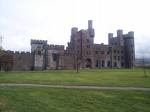
English is spoken by almost all people in Wales and is therefore the de facto main language. However, northern and western Wales retain many areas where Welsh is spoken as a first language by the majority of the population and English is learnt as a second language. 21.7% of the Welsh population is able to speak or read Welsh to some degree (based on the 2001 census), although only 16% claim to be able to speak, read and write it, which may be related to the stark differences between colloquial anD literary Welsh. According to a language survey conducted in 2004, a larger proportion than 21.7% claim to have some knowledge of the language. Today there are very few truly monoglot. Welsh speakers, other than small children, but individuals still exist who may be considered less than fluent in English and rarely speak it. There were still many monoglots as recently as the middle of the 20th century.Road signs in Wales are generally in both English and Welsh; where place names differ in the two languages, both versions are used (e.g. "Cardiff" and "Caerdydd"), the decision as to which is placed first being that of the local authority.
Welsh is a living language, used in conversation by thousands and seen throughout Wales. Welsh Language Act 1993 and the Government of Wales Act 1998 provide that the Welsh and English languages should be treated equally. Public bodies are required to prepare and implement a Welsh Language Scheme. Local councils and the Welsh Assembly Government use Welsh as an official language, issuing official literature and publicity in Welsh as well as in English. Road signs in Wales are in English and Welsh, including the Welsh versions of place names.
The Welsh people are keen to keep the language alive so Welsh is a compulsory subject for all school pupils up to the age of 16 in Wales. Welsh medium schools are also increasingly popular.
Welsh is a living language, used in conversation by thousands and seen throughout Wales. Welsh Language Act 1993 and the Government of Wales Act 1998 provide that the Welsh and English languages should be treated equally. Public bodies are required to prepare and implement a Welsh Language Scheme. Local councils and the Welsh Assembly Government use Welsh as an official language, issuing official literature and publicity in Welsh as well as in English. Road signs in Wales are in English and Welsh, including the Welsh versions of place names.
The Welsh people are keen to keep the language alive so Welsh is a compulsory subject for all school pupils up to the age of 16 in Wales. Welsh medium schools are also increasingly popular.


No hay comentarios:
Publicar un comentario